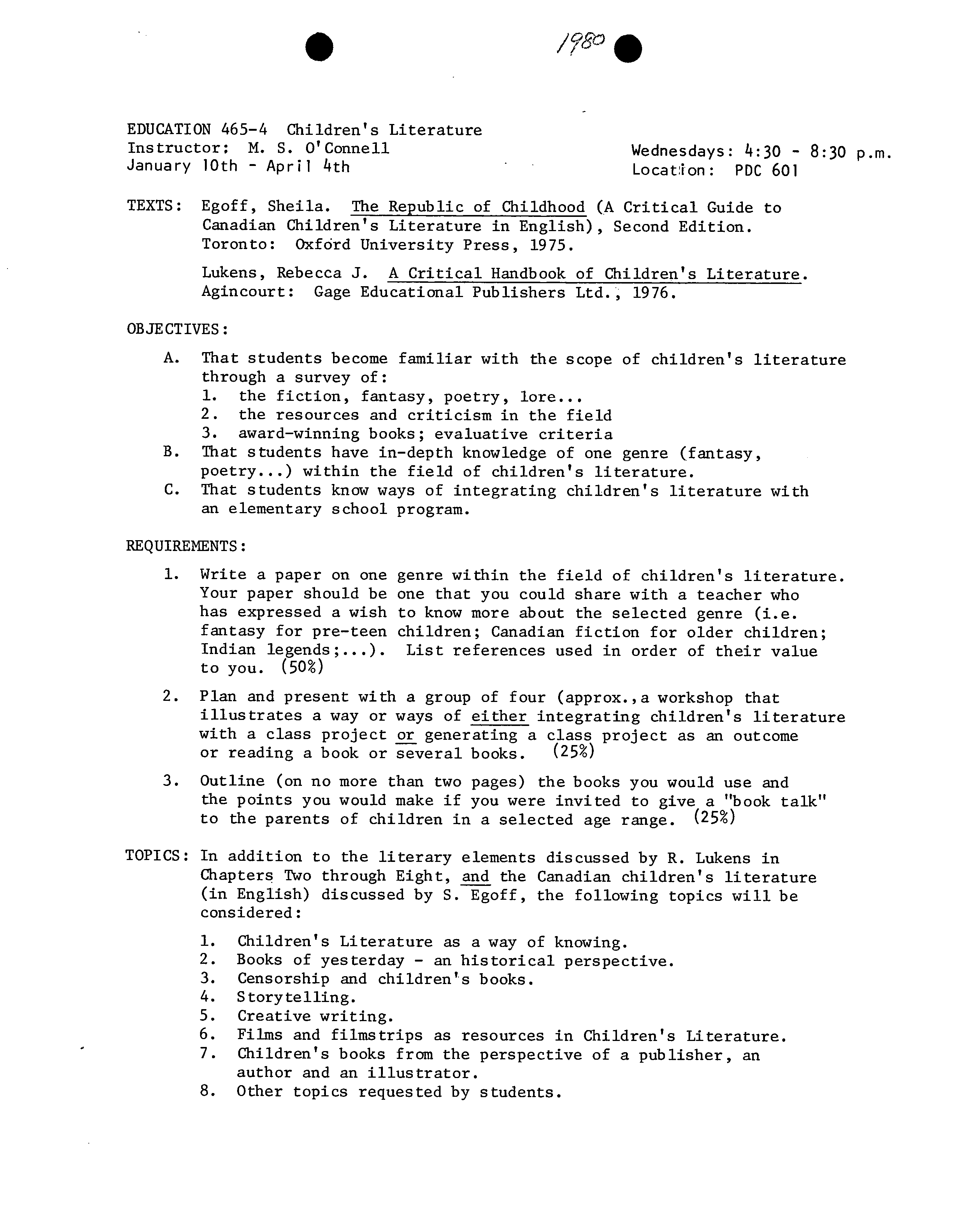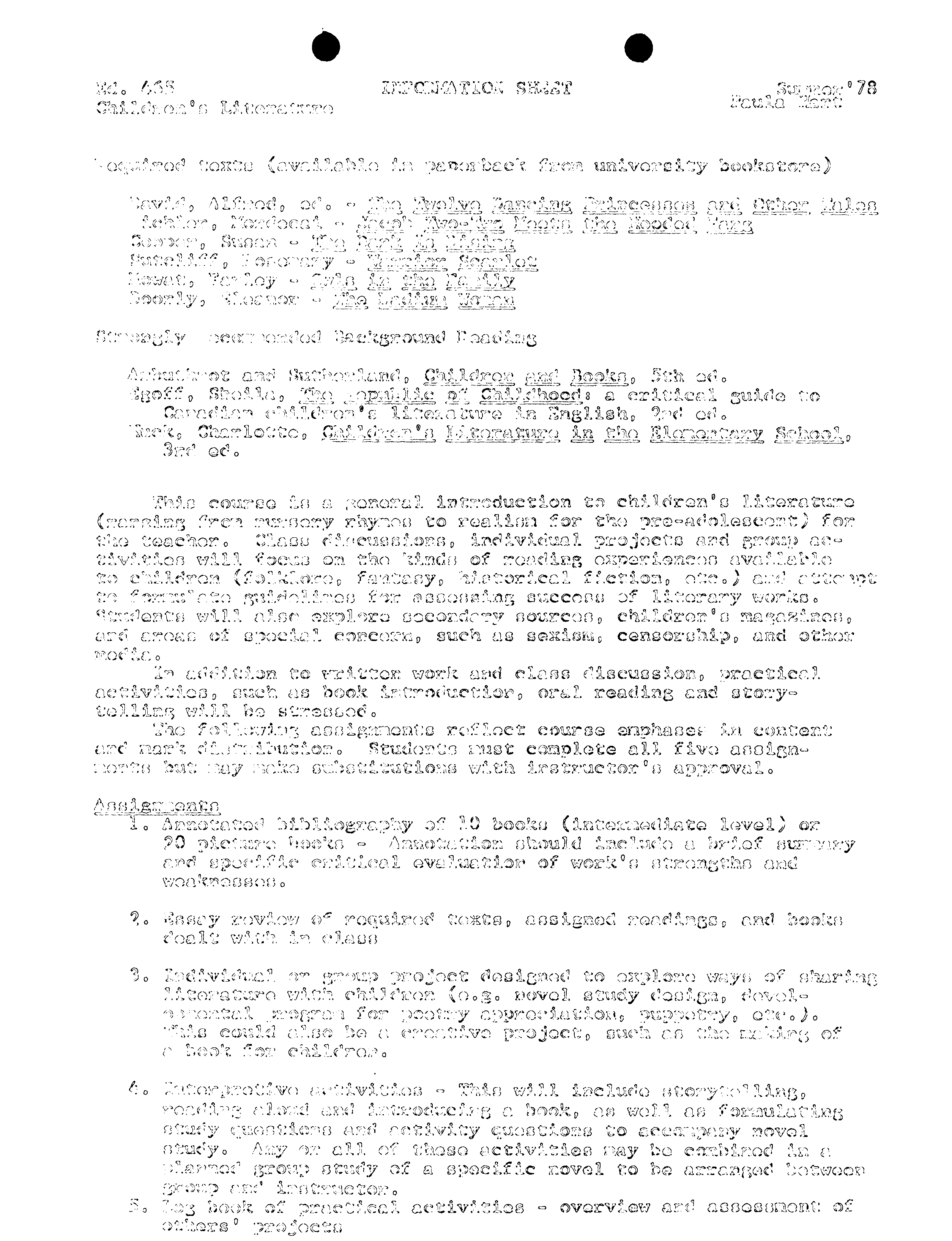.
?
oao 0
EDUCATION 465-4 Children's Literature
Instructor: M. S. O'Connell
January 10th - April 4th
Wednesdays: 4:30 - 8:30 p.m.
Location: PDC 601
TEXTS: Egoff, Sheila. The Republic of Childhood (A Critical Guide to
Canadian Children's Literature in English), Second Edition.
Toronto: Oxford University Press, 1975.
Lukens, Rebecca J. A Critical Handbook of Children's Literature.
Agincourt: Gage Educational Publishers Ltd., 1976.
OBJECTIVES:
A. That students become familiar with the scope of children's literature
through a survey of:
1.
the fiction, fantasy, poetry, lore...
2.
the resources and criticism in the field
3.
award-winning books; evaluative criteria
B. That students have in-depth knowledge of one genre (fantasy,
poetry...) within the field of children's literature.
C. That students know ways of integrating children's literature with
an elementary school program.
REQUIREMENTS:
1.
Write a paper on one genre within the field of children's literature.
Your paper should be one that you could share with a teacher who
has expressed a wish to know more about the selected genre (i.e.
fantasy for pre-teen children; Canadian fiction for older children;
Indian legends;...). List references used in order of their value
to you. (50?)
2.
Plan and present with a group of four (approx.,a workshop that
illustrates a way or ways of either integrating children's literature
with a class project or generating a class project as an outcome
or reading a book or several books.
?
(25)
3.
Outline (on no more than two pages) the books you would use and
the points you would make if you were invited to give a "book talk"
to the parents of children in a selected age range. (25%)
TOPICS: In addition to the literary elements discussed by R. Lukens in
Chapters To through Eight, and the Canadian children's literature
(in English) discussed by S. Egoff, the following topics will be
considered:
1.
Children's Literature as a way of knowing.
2.
Books of yesterday - an historical perspective.
3.
Censorship and children's books.
4. Storytelling.
5.
Creative writing.
6.
Films and filmstrips as resources in Children's Literature.
7.
Children's books from the perspective of a publisher, an
author and an illustrator.
8.
Other topics requested by students.
(^.
?
fl ?
c ?
U
'
-.'
?
(
( ?
_)
:- ?
-
f
I-,
I
c.
)
LII
0 ?
2ia
?
0
Tt ?
0 ?
2LL ?
:'
?
MM"
,
P
Cr
<-
-
?
;jy'•c-Y, ?
7
A 6 M
O
D
2: • ?
G
ac
©o ?
aa?. ?
dtc ?
coz°
?
?'° ?
f
0
Omc
) r:.'
?
Cc' ?
C
3C11:r ?
?
frQ COC3.0 Y COCCC
C ?
CC. .CCC3
?
.
e,CeC'ci, ?
L1 ?
L1CCI
C() C
0
)O& ?
G(
"IC
C
?
0
•7C
1
?
k
cjC. ?
0 ?
at c(tG ?
fiO
c):'CN ?
3J
?
Co
0 ?
0
!
?
si
CC.RCy
T ?
XCYIJ
(tLi
c
20
IU&1
('C ?
C ?
it2
C
?
C C
i
0
2
o 1CC?
?
V ?
u
ZC)C Li
Y,CDT
C C .0 0 C
0 ?
..(
'C
)C
CC
<
Cc ?
\YC
?
C
oCcy ?
?3o
0 ?
0
C
?
.fl;
:. ?
o1::
?
v ?
co.0 0 ?
0 ) 0
''o ?
CC.1
CC C.
C[.VC ?
COJOCC CC C
C
C COD CC
o ?
C ?
VC
?
-' 'CC
?
J'C) CC©
C
?
0
?
cC: ?
(CCC
';y
?
Co
C
?
CC1(Y0 ?
c)::
?
o
?
C0O ?
Cc y CI. ?
b ?
o eac
CCC
(C ?
CCCo;
0
OV/.CY CCC !
Cci3ooCaC1,C


